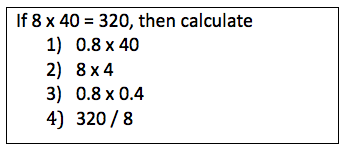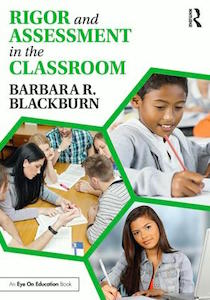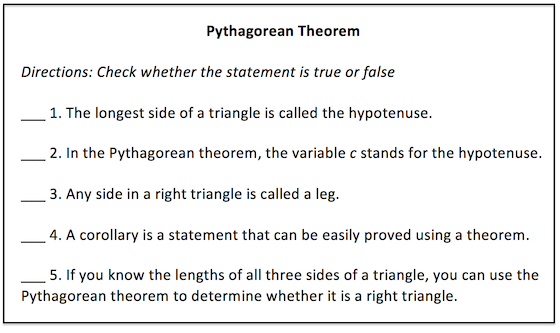School Leadership 2.0
A Network Connecting School Leaders From Around The Globe
8 Strategies to Quickly Assess Prior Knowledge
8 Strategies to Quickly Assess Prior Knowledge
BY MIDDLEWEB · PUBLISHED 12/31/2017
 By Barbara Blackburn
By Barbara Blackburn
Prior to teaching your lesson, it’s important to gauge where students are in their knowledge of the topic. We are going to look at eight simple strategies you can use to assess students before you design and carry out your lesson plan.
Discover the Mistakes
For the topic you will be teaching, create a webpage or blog entry that mimics an online encyclopedia entry. Include at least four content errors. Ask students to compare the webpage to a credible site, such as the National Geographic Channel. Their task is to correct the mistakes. This is a great way to build some prior knowledge and hone students’ analysis skills.
Anticipatory Guide
It’s important to determine what a student actually understands about a concept prior to instruction. Pat Vining, a math teacher, uses a simple activity to check her students’ prior knowledge of the concept and to clear up any misunderstandings students may have about the topic.
First, Pat gives students three minutes to answer a short true/false questionnaire. Next, in pairs, students compare responses and use the textbook to check their answers. Each set of partners must rewrite any false statements so that they are true. She ends with a whole-class discussion to ensure understanding.
Tool 107: K-W-L
Probably the most common method of identifying students’ prior knowledge that I see in classrooms today is a KWL chart. During a KWL activity, you ask the students what they already know about a topic (K) or what they think they know about it. Next, you ask what they want to know (W). Then, you teach the lesson and ask them what they learned (L). You can also add an H—How Can We Learn This to create a K-W-H-L organizer, which shifts ownership of learning to students.
 LINK Strategy
LINK Strategy
Kendra Alston adapts the KWL strategy into a LINK for her students.
 After they complete the L column individually, her students turn to a partner and share their answers. Then, she leads a short class discussion, charting out what everyone in the class knows about the topic. As she works through the lesson, students finish by writing what they now know (K), and they tear that part off to turn in as they leave her class. This provides her immediate feedback as to what her students learned or didn’t learn in class.
After they complete the L column individually, her students turn to a partner and share their answers. Then, she leads a short class discussion, charting out what everyone in the class knows about the topic. As she works through the lesson, students finish by writing what they now know (K), and they tear that part off to turn in as they leave her class. This provides her immediate feedback as to what her students learned or didn’t learn in class.
It’s important to share students’ responses with everyone, albeit it in a safe way that doesn’t embarrass anyone. That’s why I like her method. She starts by allowing each student to write an individual response, so everyone has an opportunity to think about what they know.
As Kendra points out, if I’m a student,
“…by sharing with a partner, I can feel ‘safer’ in case I’m not right. In the whole class discussion, I’m sharing ‘our’ answers (mine and my partner’s), so I don’t feel like I’m out on a limb by myself. You could even add another option of sharing with two groups of partners before you share with everyone.
Kendra adds another step:
“However, don’t sacrifice the whole class discussion. We all learn more together, and it’s a safe guess that someone in my class knows something I don’t know. Listening to all responses and charting them out for everyone to see helps me build prior knowledge when I don’t have much.”
Alike / Red Herring
I sometimes wondered how much my students knew before I told them the topic for the day. One day, I decided to let them figure out the topic first. I named multiple cities, such as Raleigh, North Carolina, Sacramento, California, and Albany, New York. After a few seconds, one student shouted, “Hey, I know—those are all state capitals!”
This is an easy way to determine what students already know, and it can be used at any grade level. A pre-kindergarten teacher can use it to introduce the color of the day, pulling items out of a box. A science teacher can use this strategy to introduce elements or subatomic particles.
To increase the rigor, Lindsay Yearta uses the “Red Herring” game with her students. She gives multiple examples that are linked, but students must identify the red herring – that’s the one that does NOT belong. Take a look at these: Arizona, Alabama, Virginia, and California. Arizona doesn’t belong because it doesn’t have a coastline. Students must also justify their choice. Again, based on their responses, you can see how much they know, and by shifting the focus to students generating information, it is more rigorous.
If / Then Statements
Jayne Bartlett, author of Outstanding Assessment for Learning in the Classroom, describes another rigorous method we can use to assess prior knowledge. Using if/then statements, students identify a connection and apply it.
Sample Math If/Then Statements
on Multiplication and Division

She explains, “to extend the if/then strategy, you can ask pupils to determine a simple rule: ‘If: taste –> tasting, heat –> heating, place –> placing, time –> timing, meet –> meeting… then what is the rule?”
Once again, by requiring students to analyze the information on their own before you step in, you have increased the rigor.
Word Sorts
Word sorts also allow you to see how much students know. In small groups, give students a set of vocabulary cards. Ask them to discuss the words and group them based on whether or not they fit in with the topic. Then, after reading a text, students revisit their word groupings and sort them again. To up the rigor even more, preview the topic and have students generate related words on their own before reading the text.
Write the Room
A final way to gauge prior knowledge is by taping posters around the room. On each one, write a word or phrase related to your topic. As students enter, they move from poster to poster writing something they know about the word or phrase. In other words, they “write the room.” Use stickies if you have multiple classes.
Conclusion
Assessing students’ prior knowledge allows you to customize your teaching to meet their needs. These simple and adaptable strategies can help you gain an understanding of what your students do and do not know in short order.
_______________
 Barbara Blackburn was named one of the Top 30 Global Gurus in Education in 2017. She is a best-selling author of 16 books including Rigor is Not a Four Letter Word and most recently Rigor and Assessment in the Classroom.
Barbara Blackburn was named one of the Top 30 Global Gurus in Education in 2017. She is a best-selling author of 16 books including Rigor is Not a Four Letter Word and most recently Rigor and Assessment in the Classroom.
A nationally recognized expert in the areas of rigor and motivation, she collaborates with schools and districts for professional development. Barbara can be reached through her website or her blog. Follow her on Twitter @BarbBlackburn.
Tags:
Replies to This Discussion
JOIN SL 2.0
SUBSCRIBE TO
SCHOOL LEADERSHIP 2.0
Feedspot named School Leadership 2.0 one of the "Top 25 Educational Leadership Blogs"
"School Leadership 2.0 is the premier virtual learning community for school leaders from around the globe."
---------------------------
Our community is a subscription-based paid service ($19.95/year or only $1.99 per month for a trial membership) that will provide school leaders with outstanding resources. Learn more about membership to this service by clicking one of our links below.
Click HERE to subscribe as an individual.
Click HERE to learn about group membership (i.e., association, leadership teams)
__________________
CREATE AN EMPLOYER PROFILE AND GET JOB ALERTS AT
SCHOOLLEADERSHIPJOBS.COM
New Partnership
Mentors.net - a Professional Development Resource
Mentors.net was founded in 1995 as a professional development resource for school administrators leading new teacher induction programs. It soon evolved into a destination where both new and student teachers could reflect on their teaching experiences. Now, nearly thirty years later, Mentors.net has taken on a new direction—serving as a platform for beginning teachers, preservice educators, and
other professionals to share their insights and experiences from the early years of teaching, with a focus on integrating artificial intelligence. We invite you to contribute by sharing your experiences in the form of a journal article, story, reflection, or timely tips, especially on how you incorporate AI into your teaching
practice. Submissions may range from a 500-word personal reflection to a 2,000-word article with formal citations.
